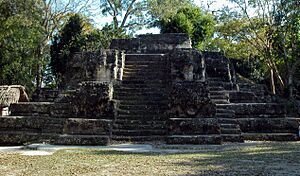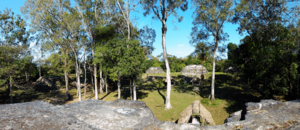E-Group facts for kids
E-Groups are special groups of buildings built by the ancient Maya people. You can find them at many old Maya cities. These buildings were very important to how Maya cities were planned.
Like many other important Maya buildings, E-Groups might have been used for studying the stars and sky. People used to think these buildings were always lined up with the sun's solstices (the longest and shortest days) and equinoxes (when day and night are equal).
However, newer research shows that these buildings were lined up in many different ways. These alignments were common across the Maya area. They were often found in other types of buildings too. These special alignments helped mark important dates for farming.
What's in a Name?
E-Groups get their name from "Group E" at a Maya city called Uaxactun. This was the first E-Group that archaeologists studied and wrote about. Uaxactun was a big city during the Classic period of Maya history.
At Uaxactun, the Group E complex has a long, stepped platform. On top of this platform are three buildings. They are lined up in a straight line from north to south. Two smaller buildings are on the sides, with a larger temple in the middle.
A staircase leads down to a plaza, which is like a big open square. This plaza was formed by Uaxactun's Pyramid E-VII. There are three stone monuments called stelae right in front of Group E. Another larger stela is between Group E and Pyramid E-VII.
Each of the four stairways in the complex has two masks on its sides. This means there are 16 masks in total!
How They Lined Up at Uaxactun
If you stood on Pyramid E-VII, the three buildings of Group E seemed to line up with the sun in special ways:
- The northern building (Temple E-I) lined up with the sunrise during the Summer (June) solstice.
- The southern building (Temple E-III) lined up with the sunrise during the Winter (December) solstice.
- The central building (Temple E-II) lined up with the sunrise during the equinoxes (in September and March).
However, scientists who dug up these sites found something interesting. These alignments might not have worked perfectly for observations. This is because the buildings and their parts were built at different times in history.
Where Can You Find E-Groups?
E-Group buildings are found at many Maya sites. They are especially common in the lowlands region. The oldest E-Groups were built during the earliest Preclassic period. This was when the first Maya ceremonial sites were being built.
This shows how important astronomy and city planning were to the Maya. They were important right from the very beginning of Maya building and design. The oldest known E-Group is at a site called Seibal.
E-Groups continued to be built during the Classic period. Some famous examples include the Lost World Pyramid at Tikal. Tikal is in the Petén Basin of northern Guatemala. Another example is Structure 5C-2nd at Cerros in Belize.
Caracol, also in Belize, has a very large E-Group. Caracol was a powerful city that even defeated Tikal during the Middle Classic period. Its E-Group is in the western part of its main city center.



